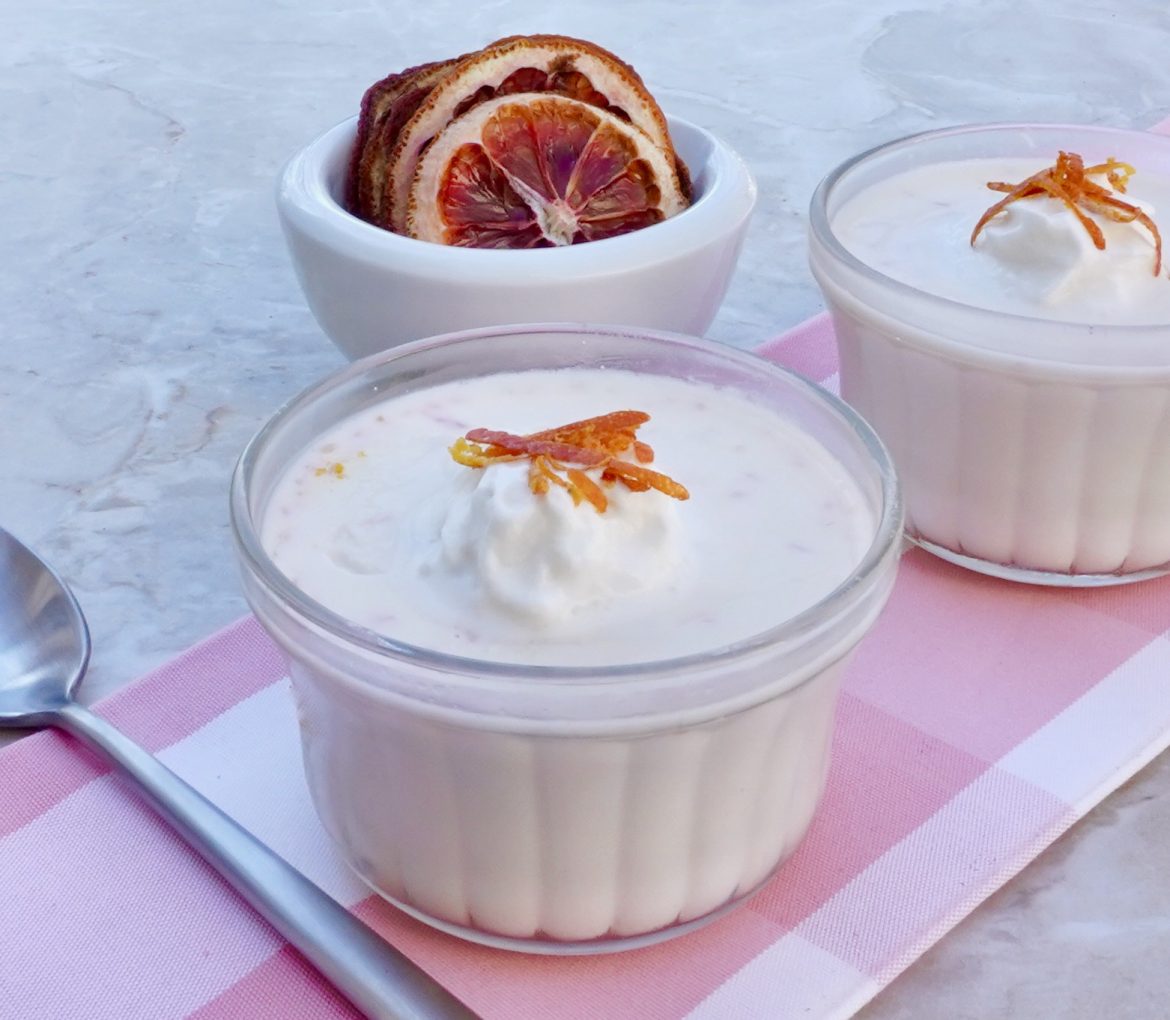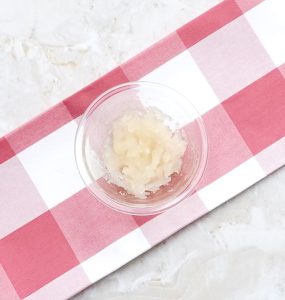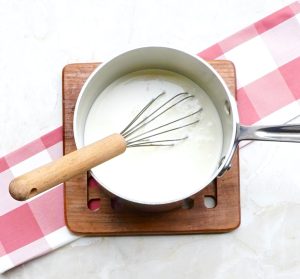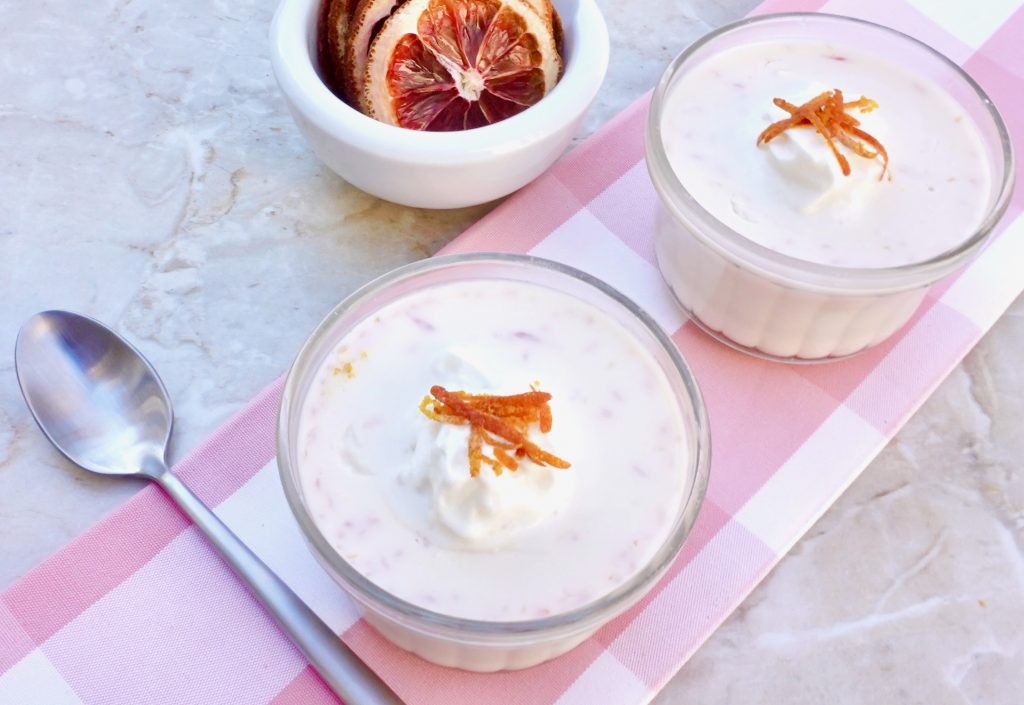Blood Orange Panna Cotta is a classic Italian dessert that is made with sweetened, orange flavored cream that has been thickened with gelatin. This simple dessert is similar to custard, but does not contain any eggs. It is light, creamy and delicious.
While Panna Cotta only takes a few minutes to make, it does take several hours for it to set though. It is a perfect dessert to make during citrus season and would be nice to serve on Valentine’s day.
This is one of those recipes that you need to read all the way to the end before you make it because the chilling time is necessary for the right consistency.
If you cannot find blood oranges you can use Cara Cara oranges or navel oranges. Blood orange has a beautiful pink color when used in icings but as it is cooked or baked the color will fade.
If you like this Blood Orange Panna Cotta recipe, check out Stawberry Panna Cotta, Pumpkin Panna Cotta and Lemon Panna Cotta made with fresh lemon juice. You might also like Gingerbread Panna Cotta.
If you want to try another blood orange recipe check out Blood Orange Yogurt Cake.
SOME THINGS TO KNOW:FAQ’S
INGREDIENT TIPS:
- The quality of the gelatin is crucial for achieving the right texture for the blood orange panna cotta. Look for a high-grade gelatin to ensure a smooth, firm set without any lumps.
- Make sure that you check the expiration date on your gelatin. Do not use it if it past the date as it will not gel properly. Read about How to Dissolve Gelatin.
- Fresh blood oranges, will have the best flavor. Blood oranges have a unique taste compared to regular oranges, offering a balance of sweetness and tartness and a hint of the flavor of fresh raspberries.
SPECIAL EQUIPMENT NEEDED:
- Small Bowl: Needed for blooming the gelatin in cold water.
- Whisk or Spoon: Essential for mixing the ingredients to ensure they are well combined and the sugar is dissolved.
- Medium Saucepan: Used to heat the cream, milk, sugar, orange juice and orange zest..
- Ramekins or Molds: These are the vessels in which the blood orange panna cotta will set. You can use traditional ramekins, custard cups, small bowls, or any other form of small, decorative molds. Glass jars or wine glasses can also be used for an elegant presentation.
- Microplane Grater or Small Box Grater: These are needed to create orange zest from the orange peel.
- Sharp Paring Knife: This is helpful to release the panna cotta from the molds.
SUBSTITUTIONS:
- Almond milk, soy milk, oat milk, or coconut milk can be used in place of the whole milk.
- The granulated white sugar can be substituted with light brown sugar.
- If you do not have vanilla extract, you can use an equal amount of vanilla bean paste
- If blood oranges are not available, use regular orange juice from navel oranges. You could also substitute other citrus fruits like tangerines or grapefruit.
HOW TO STORE BLOOD ORANGE PANNA COTTA:
- Properly stored in the refrigerator, blood orange panna cotta can last for up to 5 days. To store, cover each panna cotta with plastic wrap or a lid. This prevents the panna cotta from absorbing any odors from the refrigerator and also prevents a skin from forming on the top.
- Panna cotta can be frozen, but it’s important to note that freezing may slightly alter its creamy texture. Upon thawing, the texture might not be as smooth as when it is fresh.
- If you decide to freeze the panna cotta, do so in airtight containers. You can also wrap the individual ramekins tightly with plastic wrap and aluminum foil.
- When you are ready to eat the frozen panna cotta, thaw it in the refrigerator for several hours or overnight. Avoid thawing at room temperature as it can cause the dessert to lose its shape and texture.
Place the water into a small bowl. Sprinkle gelatin into the water and combine well. Let the mixture sit for a few minutes until the softened gelatin becomes slightly solid.
Combine the sugar, milk, heavy cream, orange juice and orange zest in a small saucepan. Bring the cream mixture to a simmer over medium heat, whisking until the sugar dissolves.
Stir the gelatin mixture into the cream and orange juice mixture and whisk until it is totally dissolved. Remove the pan from the heat and stir in the vanilla.

Blood Orange Panna Cotta
Print ThisIngredients
- 2 teaspoons powdered gelatin
- 1 and ½ tablespoons cold water
- ⅓ cup sugar (granulated)
- 1 cup cold milk
- 1 and ½ cups heavy cream
- ⅓ cup juice (blood orange or any orange can be used)
- 1 teaspoon blood orange zest
- 1 teaspoon vanilla extract
Instructions
Place the water into a small bowl. Sprinkle gelatin into the water and combine well. Let the mixture sit for a few minutes until the softened gelatin becomes slightly solid.
Combine the sugar, milk, heavy cream, orange juice and orange zest in a small saucepan. Bring the cream mixture to a simmer over medium heat, whisking until the sugar dissolves.
Stir gelatin mixture into the cream and orange juice mixture and whisk until it is totally dissolved. Remove the pan from the heat and stir in the vanilla.
Divide the panna cotta mixture evenly between six four ounce ramekins or small bowls. Each ramekin will take about a ½ cup of the mixture.
Refrigerate for at least 4 hours uncovered until it is set.
If you are not serving it at once, cover the ramekins with plastic wrap. Can be made up to 2 days in advance.
Serve the Panna Cotta well chilled, taking it out of the refrigerator 10-15 minutes before serving. This slight temperature adjustment can enhance the creaminess and flavor of the chilled panna cotta.
You can serve it in the ramekin or turn it over, run a sharp knife along the edges and release it upside down onto a serving plate.
Garnish the panna cotta with fresh whipped cream and orange zest or candied blood oranges. You could also garnish the panna cotta with some diced orange segments.








